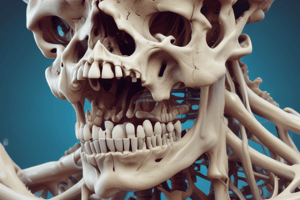Podcast
Questions and Answers
Which type of ossification is primarily responsible for the formation of long bones?
Which type of ossification is primarily responsible for the formation of long bones?
- Endochondral ossification (correct)
- Calcification
- Intramembranous ossification
- Remodeling
Osteocytes are responsible for resorbing bone tissue during bone remodeling.
Osteocytes are responsible for resorbing bone tissue during bone remodeling.
False (B)
What is the primary type of tissue that is replaced by bone during endochondral ossification?
What is the primary type of tissue that is replaced by bone during endochondral ossification?
hyaline cartilage
The region where bone grows in length and where cartilage is eventually replaced by bone forming the epiphyseal line is called the _____ plate.
The region where bone grows in length and where cartilage is eventually replaced by bone forming the epiphyseal line is called the _____ plate.
Match the following cell types with their primary function in bone formation and remodeling:
Match the following cell types with their primary function in bone formation and remodeling:
During intramembranous ossification, what type of tissue is directly converted into bone?
During intramembranous ossification, what type of tissue is directly converted into bone?
Bone remodeling only occurs during the growth phase in children and adolescents.
Bone remodeling only occurs during the growth phase in children and adolescents.
Where does the primary ossification center form during endochondral ossification in a long bone?
Where does the primary ossification center form during endochondral ossification in a long bone?
Which of the following is a primary function of osteocytes?
Which of the following is a primary function of osteocytes?
The periosteum is a thin membrane lining the medullary cavity.
The periosteum is a thin membrane lining the medullary cavity.
The spaces between trabeculae in spongy bone are filled with what?
The spaces between trabeculae in spongy bone are filled with what?
The primary mineral salt found in bone, providing hardness, is known as ______.
The primary mineral salt found in bone, providing hardness, is known as ______.
Match the bone cell type with its primary function:
Match the bone cell type with its primary function:
Which type of bone is primarily found in the epiphyses of long bones and contains trabeculae?
Which type of bone is primarily found in the epiphyses of long bones and contains trabeculae?
Sesamoid bones are classified as long bones due to their length.
Sesamoid bones are classified as long bones due to their length.
What is the name given to the region between the diaphysis and epiphysis in a growing bone, which contains the growth plate?
What is the name given to the region between the diaphysis and epiphysis in a growing bone, which contains the growth plate?
The hollow space within the diaphysis of a long bone that contains yellow bone marrow in adults is called the ______ cavity.
The hollow space within the diaphysis of a long bone that contains yellow bone marrow in adults is called the ______ cavity.
Which of the following structures allows osteocytes to communicate and exchange nutrients in compact bone?
Which of the following structures allows osteocytes to communicate and exchange nutrients in compact bone?
Bone growth in length occurs by adding bone tissue to the periosteal surface.
Bone growth in length occurs by adding bone tissue to the periosteal surface.
What is the process of blood cell formation that occurs in red bone marrow called?
What is the process of blood cell formation that occurs in red bone marrow called?
A large, rounded projection found only on the femur is known as a ______.
A large, rounded projection found only on the femur is known as a ______.
Which of the following factors does NOT significantly affect bone growth and remodeling?
Which of the following factors does NOT significantly affect bone growth and remodeling?
Match the bone marking with its description:
Match the bone marking with its description:
Flashcards
Ossification
Ossification
The process of creating new bone tissue.
Intramembranous Ossification
Intramembranous Ossification
Direct conversion of mesenchymal tissue to bone; forms flat bones.
Osteoblasts
Osteoblasts
Mesenchymal cells that differentiate into bone-forming cells.
Osteocytes
Osteocytes
Signup and view all the flashcards
Endochondral Ossification
Endochondral Ossification
Signup and view all the flashcards
Chondrocytes
Chondrocytes
Signup and view all the flashcards
Primary Ossification Center
Primary Ossification Center
Signup and view all the flashcards
Bone Remodeling
Bone Remodeling
Signup and view all the flashcards
Diaphysis
Diaphysis
Signup and view all the flashcards
Epiphyses
Epiphyses
Signup and view all the flashcards
Perforating Canals
Perforating Canals
Signup and view all the flashcards
Trabeculae
Trabeculae
Signup and view all the flashcards
Hematopoiesis
Hematopoiesis
Signup and view all the flashcards
Long Bones
Long Bones
Signup and view all the flashcards
Short Bones
Short Bones
Signup and view all the flashcards
Foramen
Foramen
Signup and view all the flashcards
Condyle
Condyle
Signup and view all the flashcards
Spine (Bone Marking)
Spine (Bone Marking)
Signup and view all the flashcards
Appositional Growth
Appositional Growth
Signup and view all the flashcards
Osteoporosis
Osteoporosis
Signup and view all the flashcards
Study Notes
The provided text has no new information, so the existing notes have not been altered.
Studying That Suits You
Use AI to generate personalized quizzes and flashcards to suit your learning preferences.




